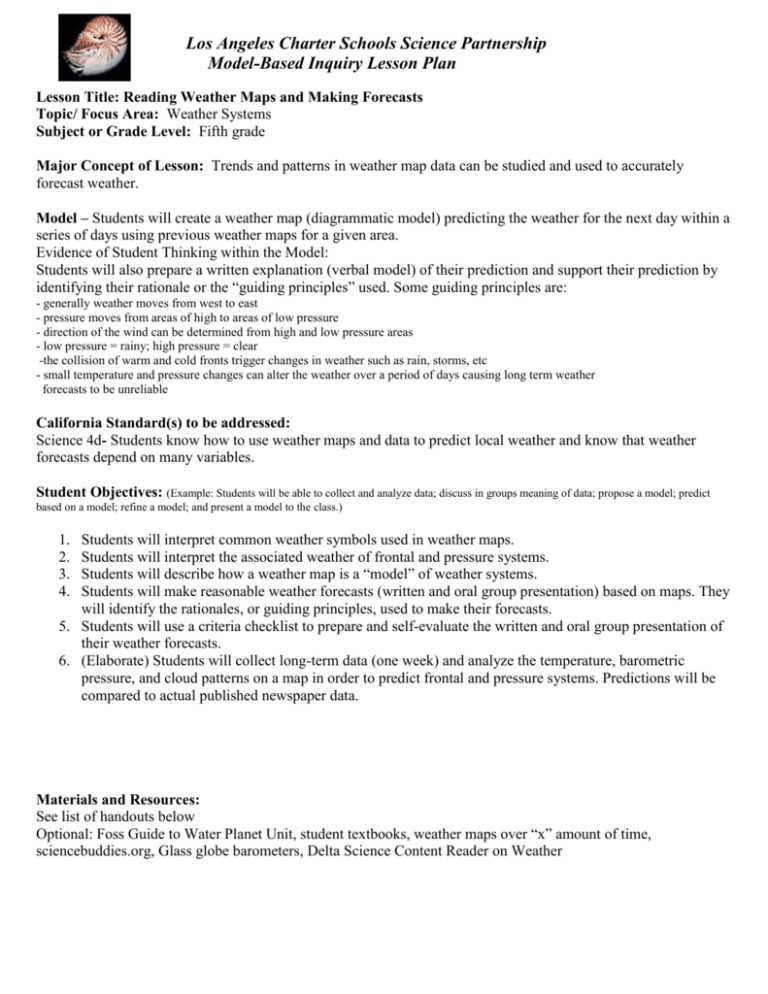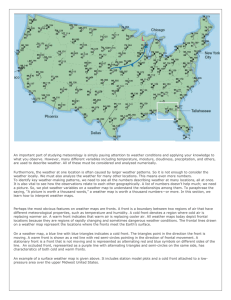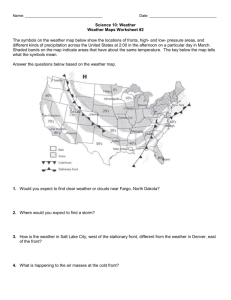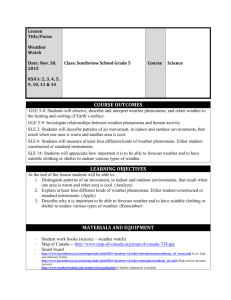Weather Maps & Forecasting: 5th Grade Lesson Plan
advertisement

Los Angeles Charter Schools Science Partnership Model-Based Inquiry Lesson Plan Lesson Title: Reading Weather Maps and Making Forecasts Topic/ Focus Area: Weather Systems Subject or Grade Level: Fifth grade Major Concept of Lesson: Trends and patterns in weather map data can be studied and used to accurately forecast weather. Model – Students will create a weather map (diagrammatic model) predicting the weather for the next day within a series of days using previous weather maps for a given area. Evidence of Student Thinking within the Model: Students will also prepare a written explanation (verbal model) of their prediction and support their prediction by identifying their rationale or the “guiding principles” used. Some guiding principles are: - generally weather moves from west to east - pressure moves from areas of high to areas of low pressure - direction of the wind can be determined from high and low pressure areas - low pressure = rainy; high pressure = clear -the collision of warm and cold fronts trigger changes in weather such as rain, storms, etc - small temperature and pressure changes can alter the weather over a period of days causing long term weather forecasts to be unreliable California Standard(s) to be addressed: Science 4d- Students know how to use weather maps and data to predict local weather and know that weather forecasts depend on many variables. Student Objectives: (Example: Students will be able to collect and analyze data; discuss in groups meaning of data; propose a model; predict based on a model; refine a model; and present a model to the class.) 1. 2. 3. 4. Students will interpret common weather symbols used in weather maps. Students will interpret the associated weather of frontal and pressure systems. Students will describe how a weather map is a “model” of weather systems. Students will make reasonable weather forecasts (written and oral group presentation) based on maps. They will identify the rationales, or guiding principles, used to make their forecasts. 5. Students will use a criteria checklist to prepare and self-evaluate the written and oral group presentation of their weather forecasts. 6. (Elaborate) Students will collect long-term data (one week) and analyze the temperature, barometric pressure, and cloud patterns on a map in order to predict frontal and pressure systems. Predictions will be compared to actual published newspaper data. Materials and Resources: See list of handouts below Optional: Foss Guide to Water Planet Unit, student textbooks, weather maps over “x” amount of time, sciencebuddies.org, Glass globe barometers, Delta Science Content Reader on Weather Lesson Implementation Logistics: (time; mechanics; preparation; safety; lesson preceding/following, etc.) Four 45-minute sessions Placement Within Unit: After students have completed investigations related to evaporation, evaporation locations, surface area, condensation, heating earth materials, convection, pressure, water cycle and severe weather, students will investigate weather maps. (Lessons follow the sequence of the FOSS Water Planet unit.) Lesson Preparation Resources needed for Session 1: Handout: “What is the Weather?” (can be projected on screen) Weather Symbols Card Set for each group Matching Activity Cards Set per group (cards show weather that will be matched up with frontal and pressure systems) Chart paper to make Guiding Principles Chart Handout: “Patterns to Know if you will be Reading a Weather Map and/or Forecasting the Weather” Glass Globe Barometers, one per group Resources needed for Session 2: Video clip of a weather report USA maps with pressure systems (to be projected, or one per student) USA maps with fronts (to be projected, or one per student) Handout: Graphic Organizer for reading article on pressure systems (for each student) Handout: Graphic Organizer for reading article on frontal systems (for each student) Informational article about pressure systems TITLE Informational article about fronts TITLE Optional: Arrange for a visit by a meteorologist Optional: Tornado Lab materials, see handout Resources needed for Session 3: Handout: “How has the Weather Changed?” (USA weather maps for two consecutive days) Handout: “Think Like A Meteorologist” (USA weather maps for 2-3 consecutive days) one per student or group Blank USA map? Handout: Weather forecast scenario and (optional) communication guide Handout: “Weather Forecast Criteria: Checklist for Students” Handout: Weather Data Chart Australia weather maps for three consecutive days Blank Australia map Resources needed for Evaluation: 3 Evaluation handouts included in this lesson (Scenario, Short Quiz, and Weather Forecast Chart Vocabulary: meteorology, meteorologist, weather, weather map, model, forecast, high pressure system, low pressure system, cold front, warm front, air mass, stationary front, precipitation, drizzle, severe weather, thunderstorm, tornado, hurricane, weather, variable, barometer Additional terms: consecutive days, rationale, guiding principles Steps of the Lesson Learning Activities which lead to Model: Inquiry-Based; ELL and or Literacy Strategies; Scaffolding Teacher Questions for Activity: Key questions that show progression from lower to higher order thinking. Anticipated Student Responses, Questions and Errors: DAY 1 (See Scenario handout:) The weather is different all over the USA. It is raining in Oregon, windy in 1. Teacher presents scenario for students about Chicago, snowing in weather. Colorado, partly cloudy in 2. Students create a model to show the types of California and sunny in weather that may be encountered. Florida. Create a model to 3. Class Discussion: Teacher explains that represent the various types symbols can be used to represent situations and/or of weather occurring in our a phenomenon. Teacher ties explanation to the country today. Use engage activity. symbols… Engage KQ: How can different types of weather be represented? What symbols did you use to represent weather? What other examples of symbols have you used in your life? What types of things are represented by symbols? Explore 1 KQ: What do some common meteorological symbols mean? Activity: Weather Symbol Cards Teacher will distribute weather symbol cards (high pressure, low pressure, cold front, warm front, stationary front, rain, partly cloudy, cloudy, sunny) to pairs of students. Each index card has the word & explanation on one side and the corresponding symbol on the other. Students predict the meanings of the symbols (without looking at the back!). After guessing, students Drawings to represent the various weather situations, creation of a key to explain drawings, color coding. Sun, curvy lines, dots, stars, colors Happy faces/sad faces for emotions, traffic signal for movement, signs on doors for entrances, exits, bathrooms, etc. What do arrows do and why do you think they are especially important? Teacher Response to Students and Teacher Intervention Activities or Strategies check their answers by turning the card over. Explain 1 1. Students discuss some of the symbols they guessed or were stumped by. Why does that symbol make sense for that type of weather? 2. Chart of Guiding Principles-Activity Teacher charts the words with their symbols and an explanation of the weather that they create. Use handout entitled: “Patterns to Know if you will be Reading a Weather Map and/or Forecasting the Weather”. Teacher emphasizes the symbols for: high pressure, low pressure, warm front, cold front, and stationary front and the associated weather. Points out that the curvature of the front symbol indicates direction in which it moves. What symbols confused you, if any? Explore 2 3. Pressure Investigation: To understand pressure better, Ss conduct Glass Globe Barometer investigation of pressure at different elevations (first floor compared to upper floors). Where is pressure greater, on the top floor or lower floor? (lower floor) Will this be called “high pressure” or “low pressure”? (high pressure) Does “high” pressure mean it’s found high up in the atmosphere? (No! It means that the pressure is great, and the numerical value is relatively large. Explore 3 KQ: What kind of weather do different types of fronts and pressure systems bring? Matching Fronts/Pressure Systems Card Activity: Students classify weather systems and the conditions that would create them. Teacher distributes envelopes containing pictures of: rain, clear skies, cloudy skies, thunderstorm, drizzle, hurricane, tornado. Also in the envelopes are images for the pressure systems and fronts. Students match the systems and fronts with the resulting weather. Explain (for Explore 3 above) 1. Groups share their matched up pairs; explain rationale. Individually students define each symbol: high How is weather in a high pressure area different than in a low pressure area? Which way is this front moving? How do you know? What happens in an area when a warm front and cold front collide? Which weather systems need to be present for each weather scenario/condition to occur? Can you support your answer by using our chart of guiding principles? pressure, low pressure, warm front, cold front and stationary front. 2. Teacher reviews again Chart of Guiding Principles DAY TWO-THREE Engage Students watch a TV weather report with the sound off and predict the weather using their knowledge of the symbols, fronts and pressure systems. What’s our weather? Students write predictions in their journal, thinkpair-share, then share with class and explain why they made the predictions. Explore 1 KQ: What are the dynamics of pressure systems and what weather do they bring? Teacher distributes (or project on screen) USA map with only the pressure systems. Students predict the weather in several locations based on the symbols on the map and provide a rationale. Students complete the “before reading” on the graphic organizer handout. Explain 1 1. Students read an informative article on pressure systems and complete the “during reading” section. Define/explain these terms: high pressure, low pressure, warm front, cold front and stationary front. Our sound doesn’t work! Watch for clues in the weather report so that we can predict the weather for today. Using your knowledge of pressure systems, what will the weather be like at each location? What did you learn from the article about pressure systems? How did you change your 2. Teacher reinforces target concepts, summarizes prediction? reading, and reinforces key vocabulary. 3. Students revisit their original predictions and revise them in the 3rd section (column) in the graphic organizer. Explore 2 KQ: What are the dynamics of frontal systems and what weather do they bring? Follow the same Explore activity procedure above, this time with an informative article on “frontal systems.” Using your knowledge of fronts, what might the weather be like in each location? Explain 2 1. Follow the same Explain procedure above, this What did you learn from the article about pressure time with an informative article on “frontal systems.” 2. Teacher engages students in TPR or kinesthetic, video clips, and animation activities to clarify the dynamics of fronts and pressure systems. See Tornado Lab Handout for an activity on how air masses interact. systems? How did you change your prediction? 3. Optional: Teacher invites meteorologist to speak to students about pressure systems and fronts. 4. Students create a model to demonstrate their understanding of pressure systems and fronts. 5. Students return to the weather report prediction from the engage and make modifications as necessary. Students explain the rationale for the changes they made. 6. T replays the weather report, but with the sound on. Sts compare their predictions with actual forecast. 4. Model: Using what you have learned about pressure systems and fronts, explain (draw, write, diagram) what kind of weather is associated with: a. pressure systems (both high and low) b. fronts (warm, cold and stationary) DAY FOUR Engage observed session 1. “How Has the Weather Changed? Map Activity Students analyze 2 consecutive weather maps to detect changes in frontal/pressure systems and the ensuing weather changes. Sts complete chart at bottom of handout. 2. Class discussion of findings. Explore observed session KQ:What reasonable weather forecast can we make by studying 2 consecutive weather maps? Meteorologist Group Mini Project: Let’s go over the arrows and lines on this map. What exactly do the arrows mean? What is this arrow referring to? Groups apply their knowledge of weather, pressure, and fronts to predict the weather for the following day and provide a written and oral prediction for their forecasts. What trends do we see in Teacher reviews Student Criteria Checklist for the first two maps? the Mini Project, emphasizing the importance of including the guiding principles in the written and oral presentations. High pressure = good weather, clear skies Low pressure = bad weather, rain and clouds You are a team of meteorologists and have Groups present their completed weather forecasts. been asked to give a weather report to the class. Optional Activities: Using the map your team 1. Each group presentation can end with a Q has created develop a and A session to further check on groups’ weather report to explain understanding of the guiding principles. tomorrow’s weather. As 2. Peer Evaluation-Using the checklist of you give oral presentation, criteria, each student can complete an be sure to refer to the evaluation of the group presentations. previous days’ maps for This gives all students added practice with clarity. the guiding principles. In your report, explain what guiding principles you are using to make your forecasts. Use the checklist to write your forecast! Be creative! Explain Elaborate KQ: How can we use weather data to predict fronts and pressure systems? 1. Investigation-Students (see data chart) record barometric pressure and temperature of the weather along with a general observation about the clouds (cloudy, sunny, windy, what types of clouds etc.) Ss record over a period of 1 school week and then analyze their data, and predict a type of front and type of pressure system. They then compare with the actual weather maps from newspaper to see if they were able to correctly match their predictions and data. Ss need to know how to use instruments. (mmHg and mb F C). Students can look up this information over the internet if necessary. Students have an opportunity to make decisions about how to collect data such as time, place, and methodology of instruments. Students write a conclusion. Explain Student groups share their findings. Evaluate Students independently complete the following assessments: 1. Scenario (see attached): A weather map is provided and student makes a forecast for a city. Student must explain rationale, guiding principles for the forecast. This is meant to be a more open-ended assessment than #3 below. 2. Short Quiz (see attached) 3. Weather Forecast Chart: Student gives a forecast by providing symbols on a map and specific details about the weather by completing a chart. Guiding Principles Handout to include: - generally weather moves from west to east - pressure moves from areas of high to areas of low pressure - direction of the wind can be determined from high and low pressure areas - low pressure = rainy; high pressure = clear -the collision of warm and cold fronts trigger changes in weather such as rain, storms, etc - small temperature and pressure changes can alter the weather over a period of days causing long term weather forecasts to be unreliable Notes: Meteorologists acquire weather data from three sources: surface measurements with traditional weather instruments, atmospheric measurements with balloons and radio sonds and satellite images. This data is displayed symbolically on weather maps. Pressure centers, weather fronts, and the winds of weather they generate are introduced. Weather is predicted using local weather maps. A weather map is a picture of the weather variables in an area at given time. Weather maps are tools used by meteorologists to forecast weather. Weather maps display high and low pressure weather fronts and precipitation.









